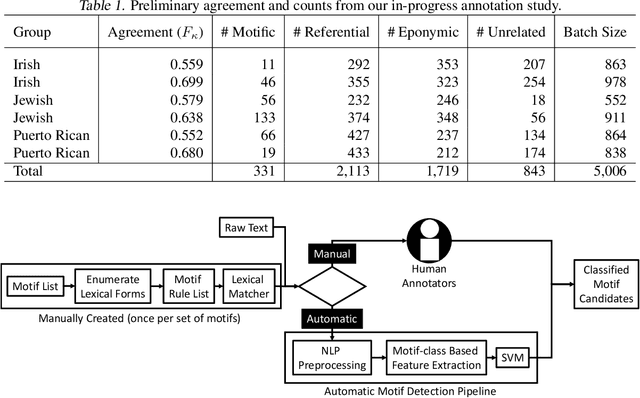David McDonald
Finding Trolls Under Bridges: Preliminary Work on a Motif Detector
Apr 12, 2022

Abstract:Motifs are distinctive recurring elements found in folklore that have significance as communicative devices in news, literature, press releases, and propaganda. Motifs concisely imply a large constellation of culturally-relevant information, and their broad usage suggests their cognitive importance as touchstones of cultural knowledge, making their detection a worthy step toward culturally-aware natural language processing tasks. Until now, folklorists and others interested in motifs have only extracted motifs from narratives manually. We present a preliminary report on the development of a system for automatically detecting motifs. We briefly describe an annotation effort to produce data for training motif detection, which is on-going. We describe our in-progress architecture in detail, which aims to capture, in part, how people determine whether or not a motif candidate is being used in a motific way. This description includes a test of an off-the-shelf metaphor detector as a feature for motif detection, which achieves a F1 of 0.35 on motifs and a macro-average F1 of 0.21 across four categories which we assign to motif candidates.
The Ninth Advances in Cognitive Systems (ACS) Conference
Jan 16, 2022Abstract:ACS is an annual meeting for research on the initial goals of artificial intelligence and cognitive science, which aimed to explain the mind in computational terms and to reproduce the entire range of human cognitive abilities in computational artifacts. Many researchers remain committed to this original vision, and Advances in Cognitive Systems provides a place to present recent results and pose new challenges for the field. The meetings bring together researchers with interests in human-level intelligence, complex cognition, integrated intelligent systems, cognitive architectures, and related topics.
Representing Inferences and their Lexicalization
Dec 14, 2021

Abstract:We have recently begun a project to develop a more effective and efficient way to marshal inferences from background knowledge to facilitate deep natural language understanding. The meaning of a word is taken to be the entities, predications, presuppositions, and potential inferences that it adds to an ongoing situation. As words compose, the minimal model in the situation evolves to limit and direct inference. At this point we have developed our computational architecture and implemented it on real text. Our focus has been on proving the feasibility of our design.
* 20 pages, 1 figure
 Add to Chrome
Add to Chrome Add to Firefox
Add to Firefox Add to Edge
Add to Edge